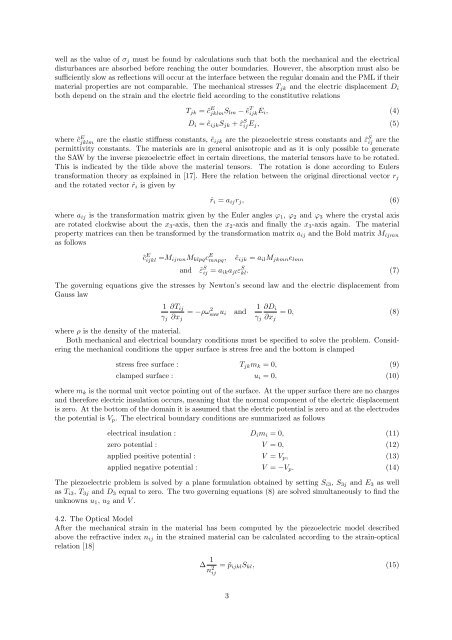Maria Bayard Dühring - Solid Mechanics
Maria Bayard Dühring - Solid Mechanics
Maria Bayard Dühring - Solid Mechanics
You also want an ePaper? Increase the reach of your titles
YUMPU automatically turns print PDFs into web optimized ePapers that Google loves.
well as the value of σj must be found by calculations such that both the mechanical and the electrical<br />
disturbances are absorbed before reaching the outer boundaries. However, the absorption must also be<br />
sufficiently slow as reflections will occur at the interface between the regular domain and the PML if their<br />
material properties are not comparable. The mechanical stresses Tjk and the electric displacement Di<br />
both depend on the strain and the electric field according to the constitutive relations<br />
Tjk = ˜c E jklmSlm − ˜e T ijkEi, (4)<br />
Di = ˜eijkSjk + ˜ε S ijEj, (5)<br />
where ˜c E jklm are the elastic stiffness constants, ˜eijk are the piezoelectric stress constants and ˜ε S ij are the<br />
permittivity constants. The materials are in general anisotropic and as it is only possible to generate<br />
the SAW by the inverse piezoelectric effect in certain directions, the material tensors have to be rotated.<br />
This is indicated by the tilde above the material tensors. The rotation is done according to Eulers<br />
transformation theory as explained in [17]. Here the relation between the original directional vector rj<br />
and the rotated vector ˆri is given by<br />
ˆri = aijrj, (6)<br />
where aij is the transformation matrix given by the Euler angles ϕ1, ϕ2 and ϕ3 where the crystal axis<br />
are rotated clockwise about the x3-axis, then the x2-axis and finally the x3-axis again. The material<br />
property matrices can then be transformed by the transformation matrix aij and the Bold matrix Mijmn<br />
as follows<br />
˜c E ijkl =MijmnMklpqc E mnpq, ˜eijk = ailMjkmnelmn<br />
and ˜ε S ij = aikajlε S kl. (7)<br />
The governing equations give the stresses by Newton’s second law and the electric displacement from<br />
Gauss law<br />
1<br />
γj<br />
∂Tij<br />
∂xj<br />
= −ρω 2 sawui<br />
and<br />
1<br />
γj<br />
∂Di<br />
= 0, (8)<br />
∂xj<br />
where ρ is the density of the material.<br />
Both mechanical and electrical boundary conditions must be specified to solve the problem. Considering<br />
the mechanical conditions the upper surface is stress free and the bottom is clamped<br />
stress free surface : Tjkmk = 0, (9)<br />
clamped surface : ui = 0, (10)<br />
where mk is the normal unit vector pointing out of the surface. At the upper surface there are no charges<br />
and therefore electric insulation occurs, meaning that the normal component of the electric displacement<br />
is zero. At the bottom of the domain it is assumed that the electric potential is zero and at the electrodes<br />
the potential is Vp. The electrical boundary conditions are summarized as follows<br />
electrical insulation : Dimi = 0, (11)<br />
zero potential : V = 0, (12)<br />
applied positive potential : V = Vp, (13)<br />
applied negative potential : V = −Vp. (14)<br />
The piezoelectric problem is solved by a plane formulation obtained by setting Si3, S3j and E3 as well<br />
as Ti3, T3j and D3 equal to zero. The two governing equations (8) are solved simultaneously to find the<br />
unknowns u1, u2 and V .<br />
4.2. The Optical Model<br />
After the mechanical strain in the material has been computed by the piezoelectric model described<br />
above the refractive index nij in the strained material can be calculated according to the strain-optical<br />
relation [18]<br />
∆ 1<br />
n 2 ij<br />
= ˜pijklSkl, (15)<br />
3
















